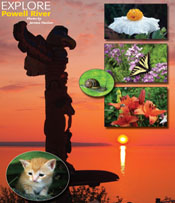September 2009
>> This entire issue is available as a 17MB PDF download
Table of Contents
Mailbag
KUDOS
A community that cares
Fall Fair: An agricultural showcase
Enviro-learning centre at Lang Creek
Helping the fish
How to paint a room
Increase your odds
Coming up
For Art's Sake
Plastics and gardens? Not a good idea
5 Hot Fishing Spots
Play, play, play...it's how children learn
Babies teach children
Breastfeeding best for baby
Choosing childcare
Preserving food in jars
Food Swings
Wildwood celebrates 80 years of community spirit
Business Connections
Pardon My Pen
Explore Powell River
Hi Sean:
Thanks so much for sending [the article on my visit to Powell River and the new Max Cameron Theatre, Powell River Living, August 2009] to me. I wanted to tell you that the Canadian ambassador to the Organization of American States was recently in Powell River on vacation and he saw the story and wrote to tell me about it! You never know where the printed word will find a reader, do you?
Max Cameron
~~~~~
Hello Isabelle,
I just wanted to thank you for the wonderful article on Bob Blackmore. (Powell River Living, February 2009). I had not heard that he had passed away. We had lost touch over the last couple of years. I was listening to CBC and they were talking about an adventurer that reminded me of Bob and so when I came down to my computer I "Googled" Bob, and up came your article.
Bob taught me photography and dark room many years ago in Nelson. We were both working at the Nelson Daily News and I spent some time in Kaslo visiting with Bob and Bev.
Your article brought back many wonderful memories. Thank you and blessings,
Marian Craft
We welcome feedback from our readers. Letters may be edited for length. Email isabelle@prliving.ca, or mail letters to PR Living, 3932 Manitoba Avenue, Powell River, BC V8A 2W6.
Swimmer makes big splash
Kudos to Adam Rahier and his gold-medal swimming efforts. At deadline, Rahier had won three golds and a silver at the Canada Games in Prince Edward Island. Earlier, he won six golds and a bronze at the CanAm Swimming Championships in Edmonton. Rahier is training in Nanaimo with Riptides.
Although his sport has been cut from the Paralympic World Championships to be held in Brazil in November, he's lobbying for the reinstatement of competitions for the intellectually disabled.
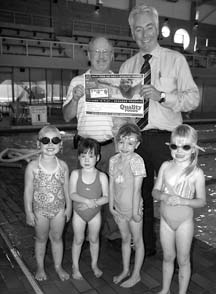 Rec Bucks are here!
Rec Bucks are here!
Kudos to Quality Foods and Powell River Parks & Recreation for their Partners in Play rewards program in which Powell River Parks & Rec offers recreation products and services as part of the Quality Foods rewards incentive program. Customers shopping at Quality Foods now have the opportunity to redeem their points for Partners in Play Rec Bucks (200,000 QF points for a $20 rec bucks voucher) and apply them towards full payment or partial payment for individual, family or group recreation products and services such as fitness passes, programs, or make donations to programs such as Send a Kid to Camp. Find out more from Quality Foods reception at the Complex.
A community that cares about its people is a special kind of community. Some people think the Leave it to Beaver kinds of neighbourhoods exist only on TV but that's not true.
Wildwood residents say they live in the kind of neighbourhood where people help each other and watch out for one another. Dagmar McKenzie's story on page 31 about Wildwood and the upcoming celebration of the Ratepayers 80th birthday talks about what life was like then and now.
Speaking of community-minded people, there's a project going on at the Lang Bay Fish Hatchery that has a group of green thumbs creating beautiful gardens with native plants on the fish hatchery grounds. It's a huge undertaking but many of the volunteers who are retired teachers say they're doing this to give back and to create something of beauty that all can enjoy.
The hatchery helps make Powell River a great place to fish, and this month we picked the brains of some of Powell River's top anglers to find some of the best places to fish. Check out the list on Page 18. You don't have to go far to find fish--another great thing about this community.
If you like flowers, be sure to visit the Fall Fair this month and check out the exhibits. There will be prize-winning baking, flowers, vegetables and livestock. For more details read Valerie Wigton's story on page 8.
Now that you've feasted on summer's bounty and the fall harvest, what do you do with it? For an adventure in canning don't miss Deb Caleron's first date with a pressure canner on page 28.
We also have a section that looks at children and the early years. We now know that the most critical period of a child's brain development is from birth to age six. These are the years when the building blocks in language and cognitive development need to be put in place so children are ready to learn language, math and complex ideas.
Whether it's ensuring that those who can breast feed do so, or choosing a good daycare, or simply spending time with kids in play, we can all play a role in giving the youngest citizens in our community a healthy start.
It's true that it takes a community to raise a child. It is also true it takes a community to create a community that cares for all its people!
Isabelle Southcott, Publisher » isabelle@prliving.ca
Fall Fair: An agricultural showcase
Displays, competitions and live animals!
By Valerie Wigton
September means shorter days, cooler weather and school.
It is also a time of reaping the bountiful harvest that nature has provided for us. Here in Powell River we are fortunate to have one of the best agricultural climates in Canada.
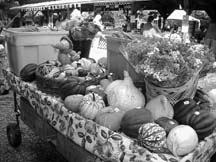 September is also the month that we celebrate this abundance from Mother Nature's larder with the annual Fall Fair.
September is also the month that we celebrate this abundance from Mother Nature's larder with the annual Fall Fair.
Started 77 years ago, the Powell River Fall Fair's mandate is the same now as it was then: to proudly showcase our local agricultural community, through displays, competitions, and live animals.
Farming has changed considerably in the past 75 years. Machinery has helped ease the work-load but government interference has increased the headaches and paperwork.
Modern farmers face challenges that our grandfathers couldn't have imagined in their wildest dreams. Meat regulations, quotas, marketing boards, factory farms, and the lists ramble endlessly on.
Despite the difficulties our local farms continue supplying the area with wholesome, quality food. The Fall Fair is about them.
This year the fair is being held the last weekend in September on the 26 and 27 from noon to 5 pm on both days. Opening ceremonies begin at 1 pm. The fair is located at the agriculture grounds (same place as the Open Air Market) on McLeod Road. Bigger than last year, there will something to entertain and educate fair patrons of all ages. Admission is still only $2 with many free events on the grounds.
There is a growing list of demonstrations honouring farming practices that date back centuries. Children can get involved with the free kid's games, face painting or go for a train ride. Visit the livestock barn and see many farm animals close up. Wander over to the horse show or get something yummy from one of the food vendors. Go for a pony cart ride or watch an artist work on a painting. You can get a massage or buy fresh food or flowers to take home. Buy a hand shawl or some new jewellery. Sit by the stage and enjoy some foot-tapping music. Don't forget to pick up a $2 raffle ticket for a chance to win more great prizes than ever.
Save your arms and take advantage of the parcel check-in run by the Girl Guides. They even have coolers to keep perishable items fresh.
Of course there are still all the competitions in the exhibition hall with everything from wine making to eggs.
There will be no parking on the grounds and fair patrons are encouraged to take advantage of the bus service this year. You can park at the north end of the Town Centre Mall. There is a designated shuttle service that goes directly from the mall to the fair grounds. It is roughly a 10 minute ride. The bus is the only vehicle allowed onto the grounds and riders get dropped off in the middle of the action. Bus riders save on gas emissions and long walks. There is no parking on Myrtle Road and only handicapped parking on McLeod Road. Parking is still available by the mailboxes on Padgett Road.
Dogs are not permitted on the grounds. Yes, this rule applies to even the really cute and tiny ones.
Fair booklets with a complete listing of classes, events, bus schedule, ground map and entry forms will be available by September 1. Packed with tons of information they can be picked up at the Open Air Market, Rainbow Valley Feed, Jumpin' Jodhpurs and Mitchell Brothers.
Watch for our enlarged children's exhibit section.
Exhibitors can drop off their entries Friday night between 6 and 9 pm at the grounds. Judging takes place Saturday morning.
On the Fall Fair weekend, the market opens the same time as the fair.
Show your support for local agriculture--we'll see you at the fair!
For more information as a vendor, competitor or visitor, call Val Wigton 604-485-4107 or email cackleberryfarmpr@hotmail.com.
Enviro-learning centre at Lang Creek
By Isabelle Southcott
Every fall thousands of spawning salmon making their way up Lang Creek return to the place of their birth while school children learn about the life cycle of the salmon.
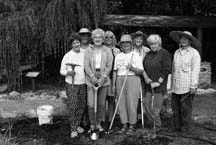 Now the facility at Lang Creek Hatchery has been expanded to include a garden where the beauty and diversity of native plants of British Columbia are being showcased.
Now the facility at Lang Creek Hatchery has been expanded to include a garden where the beauty and diversity of native plants of British Columbia are being showcased.
A large garden featuring plants like yellow woolie sunflowers, Rosey Pussy Toes, Nootka Roses, flowering red currants and White Wonder Dogwoods surround and beautify the hatchery grounds.
Retired teacher Gail Scholefield is one of the volunteers working on the project. Her eyes light up as she talks about the garden becoming an enviro-learning centre that will benefit students, adults, children, tourists and visitors.
Through the development of the garden, the centre is being expanded to include opportunities for botanical appreciation and study. An outdoor gazebo is being built by artist/educator Ed Oldfield and his volunteers so that classes can enjoy watching the salmon rain or shine.
The project was the brainchild of George Illes, vice-president of the Powell River Salmon Society. He felt a garden would enhance the property at Lang Creek and attract more tourist traffic. With the help of his wife Tommy and neighbour Scholefield, the garden project began to take shape. There have been many other volunteers who have worked hard on this project, too.
JoAnn and John Bufton of Wildwood Garden Service created a master design that included rockeries to be planted with hardy, native plants. When planting day arrived on June 13, nine enthusiastic volunteers from the Powell River Garden Club planted 245 plants under the direction of Master Gardener Shirley Cole. "As we worked shoulder to shoulder, exchanging ideas, a larger vision for the garden began to sprout and the concept of an enviro-learning centre took root," says Scholefield.
 Most of the volunteers working on the project are members of the Powell River Garden Club. Michael Stewart, Wendy Halliday and Cole are also retired school teachers.
Most of the volunteers working on the project are members of the Powell River Garden Club. Michael Stewart, Wendy Halliday and Cole are also retired school teachers.
"It's a huge community project that all comes under the Salmon Society," says Scholefield.
Phase two of the Lang Creek garden is being coordinated by Liz Kennedy and will take place in October. "We'll add more specimens and replace some of the plants that were stolen and add another small rockery," says Scholefield. "We are going to be planting for fall colour, interest plants and different textures."
Beneath a canopy of trees, Scholefield gestures to the right. "A gate will go in here. It will be wheelchair accessible and we will landscape this area. See how it is shady? We'll landscape here with native woodland plants."
Volunteers will landscape along the creek and then put up information boards. "This area over here by the grove of trees is where we want picnic tables," adds Scholefield.
What began as a small project has turned into a large community undertaking. Simply building a toilet became a major project because of the ever-present groundwater. In the end, it became a large, accessible two-toilet log-cabin facility. The toilet, garden and gazebo are just part of an $85,000 renovation to the Lang Creek spawning facility.
"We will have identification stakes with Latin and common names placed in the garden once the soaker hoses have been removed. Members of the Lang Creek Garden Committee will work towards developing educational materials for use by classroom teachers and students," says Scholefield.
Educational materials will include fun activities such as word searches and crossword puzzles and booklets.
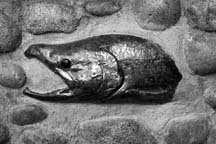
"We enjoy giving back to the community and creating something new and unique," says Scholefield. As well, volunteers enjoy the camaraderie of working on a project with like-minded people.
Volunteers are learning and having fun working on the garden and, as Scholefield says, "we are keen to encourage the next generation of gardeners, botanists and conservationists."
The Lang Creek sorting facility is a key part of Powell River's salmon enhancement efforts.
 Salmon swimming up Lang Creek are diverted into a sorting facility where a fraction of them are chosen for broodstock. Eggs and sperm are gathered and the fertilized eggs are cared for at the mill hatchery, where cool Powell Lake water guarantees survival rates over 90 per cent. Some of those eggs, or, later, small fish, are shared with other hatcheries or river-restocking efforts, including Sechelt, Chapman Creek, Sliammon, Theodosia, Willingdon Beach and Texada.
Salmon swimming up Lang Creek are diverted into a sorting facility where a fraction of them are chosen for broodstock. Eggs and sperm are gathered and the fertilized eggs are cared for at the mill hatchery, where cool Powell Lake water guarantees survival rates over 90 per cent. Some of those eggs, or, later, small fish, are shared with other hatcheries or river-restocking efforts, including Sechelt, Chapman Creek, Sliammon, Theodosia, Willingdon Beach and Texada.
The Powell River Salmon Society raises as many as 1.6 million Chinook each year. Another 300,000 coho are also raised and released into Duck Lake or Lang Creek. Another 800,000 chum salmon are also raised by the Society.
The efforts are paying off. A healthy recreational fishery has developed in the late summer as thousands of those fish return to Lang Creek. Commercial fishers also intercept many of the salmon produced here. And the number of salmon surviving to return to the creek is also on the rise.
The work of the Powell River Salmon Society at Lang Creek spawning channel, the upstream hatchery and Duck Lake net pens, and the mill hatchery are all supported by the same annual $188,000 contract from the Department of Fisheries and Oceans that the Salmon Society had in 1982. The expansion of the programs has been made possible by community support and the Pacific Salmon Foundation, which is holding a fundraising dinner here on October 17.
How to paint a room
Tips from Powell River's paint experts on getting the best finish
Preparation is key to getting a good finish, and to not ruining floors or furniture.
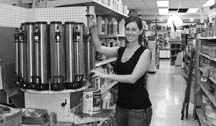 Ensure that drop sheets cover anything that you don't want to get splattered.
Ensure that drop sheets cover anything that you don't want to get splattered.
If you're painting the ceiling, it should be done first. It's a general rule when painting to start at the top and work down. Often to freshen up a room, though, you can get away without repainting the ceiling--a job that may be better left to the pros.
When masking the areas you don't want painted, don't put tape on fresh paint. Instead, use clean edge. For other surfaces, even straight masking tape is a little risky, and may damage the finish. Instead, use painter's tape. Having trouble taping around wall sconces? Try placing a plastic bag over the fixture and just tape next to the wall.
Wash the wall first to make sure you're not sanding the dirt into the wall. For a deep clean, use TSP, especially in the kitchen, where there may be grease spots. If you're painting over a high gloss finish, TSP will dull that sheen so the next coat will stick. Be sure to completely rinse TSP or the new paint won't adhere properly, says Laura Otto at Valley Building Supplies' paint department.
Then sand, fill any dents or cracks with spackle, then sand those filled spots. Wipe the dust off the wall with a damp cloth, then prime everything. You can spot-prime repaired areas if there are only a few, but if you made extensive repairs, prime the whole wall. It's really important to ensure primer goes over any filler, or it will create a shiny spot on the wall.
Once the wall is primed, a good quality paint should require only two top coats, even for darker colours.
Using a good quality brush and roller sleeve is critical to getting an even finish, but it also save up to 25 per cent in time, says Dave Howes, of Benjamin Moore Sunshine Decor. A good brush holds more paint so you're dipping less often, and you're not working with a dry brush, which leaves streaks. A good roller sleeve also holds more paint, and doesn't leave fuzz on the wall.
"Cheap fabric won't hold paint and you're constantly refilling," says Howes.
Choosing a good paint also pays off in the long run, says Howes. "It puts a higher build on the wall; it hides better; and it has more washability. You get better square-foot coverage from a can. It will last many more years that economy paint."
Otto says latex is usually easier to use and to clean up, but that many people have good reasons for being sold on oil-based paints.
She recommends choosing your finish depending on the room.
"The lower the sheen, the less it shows imperfections on the wall, but the higher the sheen, the easier it is to clean," says Otto.
When the painting is finished, remove the tape as soon as possible.
"The longer you leave it, the stronger it sets," says Howes.
Increase your odds
Road safety
By Debbie Dee
There is one choice you can make that will dramatically increase your chances of surviving a crash, regardless of who is driving the other vehicle. "Ensure that you wear your seat belt properly, and that everyone else in your vehicle is protected by a seat belt or child restraint. Seat belts save about 1,000 lives a year in Canada," says Constable Kerri Chard of the Powell River RCMP.
Canadians are among the most mobile people on earth. We have 900,000 kilometres of roads, 22 million licensed drivers and 20 million registered vehicles. These numbers don't even include other road users: cyclists and pedestrians.
Did you know?
» 30,000 people in Canada lose their lives each year in car crashes.
» There are 1,300 crashes involving cyclists in British Columbia each year.
» 22% of fatalities can be directly attributed to speeding.
» 30% of fatalities are caused by alcohol impairment.
» 20% of crashes are due to failure to obey signs and lights at intersections.
ICBC has offered some useful tips for cyclists and pedestrians that will help ensure we share the road safely. Wear bright reflective clothing to be easily spotted during the day and a night light after dark. Don't rush. Stop and look in all directions before moving out of an intersection, driveway or lane. Obey all signs and make sure you see and are seen. The majority of children's injuries are caused by the child darting out onto a roadway without looking. Always wear an approved bicycle helmet. It's the law and you could be fined for not wearing one. Bike helmets alone can prevent 85% of serious injuries, which account for 80% of all bicycle-related deaths. Make sure your helmet is made by a recognizable name, and more importantly that it fits properly. Always ride on the proper side of the road and do not weave in and out of traffic. Think and look ahead: conflict between a car and a bicycle will result in an injury to the cyclist.
Other road users should keep their eyes peeled and always look for cyclists on the road, especially in the spring and summer and during the first few weeks back to school. Be cautious especially near school zones and intersections. Don't drive too close to a cyclist as their movements can be unpredictable and watch for cyclists when exiting your car on the street as they may be coming up beside you. Look before you open your door. Be considerate: pedestrians and cyclists are vulnerable and don't have the protection of the shell of a vehicle or a seatbelt.
Being safe on the road also includes keeping your vehicle in top mechanical condition.
Keeping children safe in the vehicle is the topic of extensive research and there are new standards for car seats and booster seats and strict rules to follow when children are riding the car. Infants under one year and less than 20 pounds face the rear only and infants under one year who are heavier than 20 pounds require a special seat. Between 20 and 40 pounds children can sit in a front-facing safety seat. Children should stay in full harness safety seats until they are at least 40 pounds. After the safety seats are no longer required the child can then use a belt-positioning booster seat and the adult lap and shoulder system should not be used alone until the child is at least 4'9". Never leave your child unattended in your vehicle.
Always buckle up and do not talk on the phone while driving. If you must use your phone, find a safe place to pull over and then make that call. Do not speed. Driving at 25 kilometres faster than the posted speed increases your risk of crashing by 10 times and presents a 44% greater force on impact. Speeding does not simply involve exceeding the speed limit. Driving too fast for weather conditions can be just as dangerous. Wet or snowy roads, heavy traffic, schools and roadside activity all require you to modify your speed accordingly. Leave your anger outside the vehicle. An angry driver is a very dangerous driver.
So you think you can write?
Then your skills are needed! The Powell River Writer's Conference has teamed up with Powell River Tourism to promote tourism with a contest entitled "So You Think You Can Write?" Each entry costs $10, which also includes a year's membership in the writer's conference.
Keep stories to 300 words and poems to 20 lines. The subject? Why people should visit Powell River--Howe Sound to Lund. Entries are due by September 18, 2009. Local travel magazine editors will review all entries and reduce the list to the final 10 entries. The authors will present their entries at the October 17th workshop at Vancouver Island University in front of three judges (just like on Canadian Idol). The winner's entry will be published.
For more information call Jennifer at 604 485-0564 or visit the Writer's Conference website for details at www.prwriters.org.
Mix It Up!
The public is invited to a business mixer being sponsored by the Powell River Chamber of Commerce and Powell River Women in Business on Tuesday, September 22 at the Town Centre Hotel from 5:30-7:30 pm. There will be free appetizers, a no host bar, and booths showcasing local businesses, products and services.
Everyone is invited to come out and see what local businesses they have to offer, meet local business people and find out who the movers and shakers are.
You might even win a door prize! Contact Bonnie for more information: 604 485-0003 or bonnie@prliving.ca.
Music Fest Labour Day weekend
Don't miss the 28th annual Sunshine Music Festival September 5 and 6 at Palm Beach.
The popular festival always features great music, tons of fun, tasty food (their corn on the cob comes highly recommended). You'll find music lovers groovin' to the music, kids dancing and everyone happy to hang out and listen to the great tunes of Outlaw Social, Mud Dog, Jambanja, Wil, Todd Butler, The Clumsy Lovers, Pawnshop Diamond, James Thomas, Joel Fafard, Steve Mahoney, Jon and Roy.
It's a bit of folk, blues, jazz, a bit of storytelling and marimba under the big top all at picturesque Palm Beach. For up to date information visit sunshinemusicfest.com.
For Art's Sake
See you at the Max!
By Jessica Colasanto
September means back to school--but that doesn't necessarily mean back to the books, because September also means the start of a brand new season at the Max Cameron Theatre. Located on the campus of Brooks Secondary School, the 400-seat theatre is an ultra-modern performing arts facility.
On nine special Saturday mornings, patrons can find themselves transported to New York City to experience live performances at the Metropolitan Opera via HDTV broadcasts. The dedicated following of music lovers supporting Max's Live at the Met series continues to grow, but world-class opera isn't the only thing the Max Cameron Theatre offers.
"The theatre was built with the intention of providing a student-friendly facility to enhance and support the instrumental, choral, dance, drama, film and video programs in the school," says theatre manager Jacquie Dawson. While it is frequently used by Brooks as well as other schools in the district, Dawson says that approximately half of available stage time is open to the community. Of that, it's a fairly even split between outside private bookings and the presentations brought in by the theatre--the Live at the Met and the Experience Entertainment Performance Series.
Last year Dawson was paying close attention to audience response at the various live performances. Those preferences and interests were key in shaping this year's Experience series. "We have included a wide range of performers and groups that encompass the strong community connections to music and dance, as well as the town's rich aboriginal history," she says.
Barney Bentall kicks off the season on September 23, just one day after the release of his new album, The Inside Passage. Growing up, Bentall spent his summers on the coast, and he says the new songs reflect "the pull of the sea as it collides with the Coastal range."
Later in the season, Max presents a double-bill featuring Matt Andersen and Wil. (Wil also happens to be the headline act at this year's Sunshine Music Festival, held at Palm Beach Park on September 5 and 6.) Another live band headed our way is Kutapira, a youth group that is "forging new links between the traditions of Zimbabwe's marimba music and the rhythmic soul of Afro-Cuban drumming."
Ballet Jörgen's gorgeous presentation of Romeo and Juliet last year was so well received that they're back again, this time with Cinderella. Ballet Jörgen is the only major Canadian ballet company with a repertoire consisting exclusively of original works, and this promises to be an innovative take on the classic fairy tale: Cinderella is tormented by her sisters until her life is changed by the appearance of an old woman, a seed and magical fairies.
Raven Stole the Sun is another spectacle you won't want to miss. This traditional Aboriginal story comes to us as a compelling, contemporary theatre dance piece presented by the dynamic Red Sky Performance company. Students will enjoy an afternoon performance, while an evening show is scheduled for the public.
Upcoming private bookings include a Chicago tribute band and an evening of spoken word by the Powell River Live Poets Guild. The stage will feature many Festival of the Performing Arts and Kathaumixw performances as well. Opening and closing ceremonies of both the Vancouver 2010 Olympics and Paralympics will be broadcast live in HDTV. Max's big screen is also the local home of the Banff Mountain Film Festival.
Monitors in the lobby, backstage, and dressing rooms display what's happening on stage, and technicians enjoy wireless communication throughout the facility. Event management software facilitates booking and ensures there are no conflicts in the busy schedule.
For a full schedule and detailed information about upcoming performances, visit MaxCameronTheatre.ca. See you at the Max!
Do you have an upcoming art event? Let us know at arts@prlving.ca.
Plastics and gardens? Not a good idea
By Emma Levez Larocque
Gardening is supposed to be all about communing with nature, isn't it? I am a new gardener, so I could be wrong, but that's what I have always thought. It's all about the earthworms, and getting your hands dirty. It's about rain and sun and earth all rolled into a beautiful flower, or a lip-smacking carrot. Some of the tastiest meals I have had have come straight from a garden. There's something about gardening that seems so primal and earthy; something so right.
But as I have been learning more about gardening, and venturing out to get my hands dirty, I've been noticing that there is quite a bit that doesn't seem to fit this wholesome picture. Chemicals, for one, but that's a whole other story. It's the plastic involved in gardening that I have been thinking a lot about lately--there's A LOT of it, and that doesn't seem very "earthy" to me.
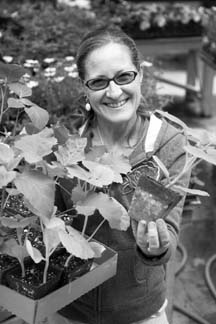 Sometime in the 1950s plastic started becoming a big part of the gardening scene, and it has proliferated through the years. Pots and plug trays, greenhouse plastic, mulch, irrigation pipe, hoses, and tapeÉ pretty much anywhere you look there is plastic to be seen. Plastic makes gardening easier, more convenient and more affordable both on a large scale and for home gardeners. But after almost 60 years, the consequences of using and disposing of so much plastic is catching up with us. It is, in fact, threatening the very basic elements that make gardening such a pleasure.
Sometime in the 1950s plastic started becoming a big part of the gardening scene, and it has proliferated through the years. Pots and plug trays, greenhouse plastic, mulch, irrigation pipe, hoses, and tapeÉ pretty much anywhere you look there is plastic to be seen. Plastic makes gardening easier, more convenient and more affordable both on a large scale and for home gardeners. But after almost 60 years, the consequences of using and disposing of so much plastic is catching up with us. It is, in fact, threatening the very basic elements that make gardening such a pleasure.
"Plastic keeps the soil untouched by sunshine, air, dew, or rainfall." I read this in an article called Gardening Without Plastic on www.ezinearticles.com which was all about plastic mulch. Plastic mulch? This is the stuff we're growing our food in? I shake my head trying to figure out how that can possibly be good for the earth, or us.
I went to see Dave Sarnowski, owner of Springtime Garden Centre in Cranberry, and he told me that the topic of plastic in gardening has been weighing on some of his customers' minds.
"There is a lot of plastic that could be eliminated," Dave says. "The industry standards could be better... there's a timed obsolescence from the industry because they don't want the plastic to last forever: they want it to break and crack so that we will buy more." But the truth is, it DOES last forever. It just does so in our landfills and our oceans. A lot boils down to the individual, Dave continues. "There is a lot of stuff you can reuse, and a lot of stuff you can recycle." Customers can take clean plastic pots back to the nursery and they will reuse them if they can, or recycle them if they can't. They also collect plastic pots and give them away to customers who want them.
Now, I realize that plastic probably makes life a lot easier for the average gardener. It's convenient and it's cheap. But as we are realizing with plastics we use in other areas of our lives, convenient, cheap and easy doesn't always equal the best way to do things.
If you want to cut down on the plastic in your garden, try these ideas from plastic-savvy Powell River green thumbs:
- Use cut milk cartons, cardboard egg cartons or newspaper for seeding containers (or save the containers you get from your garden centre and use them again the next year).
- Use popsicle sticks for labelling instead of plastic labels.
- If you're looking for a new compost bin, try making one out of untreated wood (wood pallets are perfect), or heavy mesh wire. There are lots of websites with ideas and plans for these.
- If you're getting lots of soil, get a truck load delivery instead of buying lots of bags (it's MUCH cheaper too).
- Use old fishing net or cotton net instead of plastic net for supporting climbers.
- Look around your house for things you can re-purpose into planters--glass containers, old baskets, old pots, metal pails--even old boots can make creative and attractive pots to grow things in.
- Choose rubber hoses instead of plastic--they will last much longer, and they won't deteriorate in the sun.
- Choose metal/wood garden tools instead of plastic ones.
- Use landscape cloth, newspaper or other natural materials covered with wood chips or rocks to control weeds (instead of plastic sheeting).
5 Hot Fishing Spots
by Sean Percy
September can be one of the hottest fishing times of the year, and we don't want you to miss out. So we consulted with some of Powell River's top anglers, including local outfitter Sam Sansalone of Powell River Outdoors, to get our readers some hot spots for hot weather.
At first they wanted to keep their secrets. But a bribe of three smelly herring had them spilling their guts--all eager to share their five most fabulous fishing spots on the salt chuck--in exchange for the bait. Then we threatened to break their fly rods if they didn't cough up the same information about fresh water.
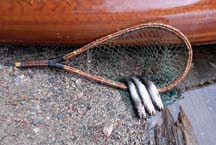
Ocean fishing
Harwood Island was a top pick among the anglers, in no small part because you can fish so many areas around the island. You weren't allowed to keep Chinook on the west side of Harwood until the closure ended August 15, so this area should be ripe. But the island has lots of other fishing grounds, too, and it's one of the more consistent spots around. Plus, you can set your crab trap before you start fishing and pick it up on the way home. Fish deep: 120 feet or more.
Coho (Kiddie) Point on Texada Island was probably the most popular choice. You can tuck in behind the point on either side if the wind starts to blow, and the point is aptly named.
Grant's Reef got Sansalone's vote as the most exciting place to fish, because of the variety of catches possible. Drop your hook there, and you might catch a lingcod, a salmon, a rockfish, a red snapper (yelloweye rockfish), a dogfish, or something even more unusual. But you have to watch the weather here; you're a long way from shelter.
Westview, from Grief Point to the mill, is often overlooked as a hot fishing spot because it's so close, but it can be as good as any. "It's ideal for small boats and you don't have to go far. You can even go after work," said Sansalone.
Lang Creek's hatchery fishery is getting progressively better, and from August through September, you don't even need a boat, as coho and chinook feed in the Lang Creek estuary before heading upstream to spawn. You can fish right from shore, but only below the Lang Creek bridge.
Fresh Water
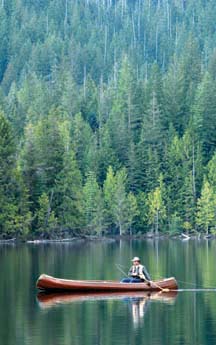 Inland Lake--Despite it's popularity with hikers, bikers, campers and families, Inland Lake remains popular for die-hard anglers, too. It's one of the few lakes you can fish from shore and do really well, partly because you can walk around the entire lake on the well-groomed trail. Regulations requiring the release of larger fish mean that this lake is home to some trophy-sized fish.
Inland Lake--Despite it's popularity with hikers, bikers, campers and families, Inland Lake remains popular for die-hard anglers, too. It's one of the few lakes you can fish from shore and do really well, partly because you can walk around the entire lake on the well-groomed trail. Regulations requiring the release of larger fish mean that this lake is home to some trophy-sized fish.
Lois Lake has similar rules to Inland, requiring the release of larger fish. It's home to large rainbow trout and some hefty cutthroats. Kids will have a blast hauling in large fish. Try near the dam and near the fish farm pens.
Cranberry Lake scored high with fly fishermen. Often overlooked and underrated because it's right within the city, it's a highly productive lake teeming with cutthroats. And contrary to popular belief, "you won't find a better tasting fish," says Sansalone.
Freda Lake is accessible only on radio-controlled logging roads, but the effort to reach the lake is worth it. Because of the high elevation, the water stays cooler, and the fish stay hungry.
Powell Lake has returned to favour with many anglers, because they're catching big fish in big numbers. If you're not catching fish on Powell Lake, go deeper. Some old-timers attach a one or two-ounce weight to their trolls. Try the mouths of the Olsen River, Beartooth Creek and in front of Haywire Bay. Or, head up into Goat Lake, for cutthroats, rainbows and the crossbred cutbows. Again, you'll have the best luck at the river mouths and creeks. Watch for mountain goats on the rock bluffs.
Play, play, play...it's how children learn
By Heather Gordon
Imagine if the most important thing you had to do each day was to play? That sounds like a great way to pass the time to me! And when you're little--life should be like that. Play, play, play. Play is the important work of being a child. Children learn through play. At Success By 6, part of our mandate is to support parents and caregivers to give their children the best possible start in life.
One important way to do this is to play with your child, to enjoy the world with your child and to have fun being together. Playing together can help to build strong relationships; playing can help your child develop new skills, to practice using hands and fingers and legs that jump high. Play can help your child understand the world in new ways and to interact with others well. Play is critical to being a child and critical in the learning process--especially in the early years, from birth to age six.
Powell River's new ORCA Bus is a bus filled with activities and fun for children ages 0Ð6 and their parents or caregivers. The best part is that the ORCA Bus is designed to give parents and caregivers an opportunity to learn new ways to play with their child. The ORCA Bus will be busy serving families later this month after our summer break. We're growing our timetable so check for the schedule on-line at www.successby6powellriver.ca
We're on the lookout for volunteers. Through School District #47's outreach Strong Start program, the bus will be staffed a few mornings each week with an Early Childhood Education specialist to offer a morning program for local children and families, and to support our team of volunteers with planning and resources throughout the year that will meet the needs of families in our community. So if you're new to working with young children but would still like to be involved, we expect to be able to offer lots of support this year to make the experience terrific for families, children and volunteers.
Contact Kim, the ORCA Bus coordinator at 604 485-2132 if you can spare a few hours a week to be involved. Volunteers can work with parents and children on the bus or behind the scenes in a variety of ways. Kim can help to find the right opportunity for you.
We're also keen to have local businesses join the ORCA Bus team as sponsors. Call us for details or to schedule a visit from Success By 6.
Babies teach children
Roots of Empathy
In his first year of life, Eugene Souch taught a Grade 7 class. Eugene, now just over a year, was the "teacher" of the Roots of Empathy program at James Thompson Elementary School. His mom, Alexandria Louie, brought her baby to class occasionally throughout the school year, with Roots of Empathy instructor Susan Hill.
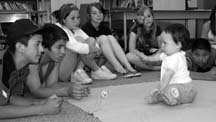 Roots of Empathy is a social/emotional competence program that has shown significant and lasting effects in reducing levels of aggression among school children. It was introduced in Powell River five years ago, said Rita John, early learning coordinator for School District 47. "Last year was the first year all the Kindergarten classes had a Roots of Empathy family visit them. The Roots of Empathy children have gone from being two to four months old to having their first birthday!"
Roots of Empathy is a social/emotional competence program that has shown significant and lasting effects in reducing levels of aggression among school children. It was introduced in Powell River five years ago, said Rita John, early learning coordinator for School District 47. "Last year was the first year all the Kindergarten classes had a Roots of Empathy family visit them. The Roots of Empathy children have gone from being two to four months old to having their first birthday!"
"While these babies were growing, SD47's students were watching them grow, getting to know them and making a connection," said Rita. When babies and parents visited the classroom, Susan led the class through a discussion that is based on observing the baby and tuning in to the baby's needs and feelings. Children then take that learning and apply it to their own relationships.
"The kids learned all the new things that were happening with him (Eugene) and how he grows and his temperament. They learned his favourite foods and his feelings," said Alexandra. "We had lots of fun coming here." She says the students had lots of good questions. And Eugene, who was three months old when he started teaching, was soaking it all in, too. "He recognized some of (the Grade 7s) when he came in. It was fun to watch them watch him grow." The program is well-established for Kindergarten students, but Susan said she really wanted to expand it to Grade 7s and was pleased with the results. "I really like doing the older grades," said Susan. "Grade 7s really get how much work a baby is and how hard it is to look after him and keep him safe."
The students showed how much they appreciated Eugene's visits by making up rap rhymes for him and even creating a patterned crib toy for him. Jade Pihl, who was in the Grade 7 class that "graduated" Eugene in June, said, "It was fun seeing him grow and how much he has changed over the past six months." Jade says she already knew about babies from caring for a family friend's young daughter. But the visits from Eugene showed her how much work it is to create a safe environment for the baby. Classmate Ryan Pielle also grew up with babies, but said the visits helped him better identify the stages the baby goes through. "It surprised me how much work it is," said Ryan. "The baby really is the teacher," said Susan.
"The baby teaches students what they are communicating when they are crying, how they grow, what is needed to keep them safe. It is concrete rather than abstract from a book and there is a face to the child. He or she is a person," said Rita.
She is convinced that Mary Gordon, founder of Roots of Empathy, got it right when she said that babies open up the heart to emotional learning by creating civil societies one child at a time.
Breastfeeding best for baby
Builds physical and emotional connections
Breast milk is the most complete form of nutrition for infants. It has exactly the right amount of fat, sugar, water and protein the baby needs for growth and development, says Dr Paul Martiquet, Medical Health Officer for the Coast Garibaldi Region.
 For most babies, breastfeeding exclusively for the first six months then combining breastfeeding with nutritious complementary foods for the next two years is the best choice for health and development.
For most babies, breastfeeding exclusively for the first six months then combining breastfeeding with nutritious complementary foods for the next two years is the best choice for health and development.
Not only do babies digest breast milk better than formula, breast milk also contains antibodies to fight off infection and disease. As well, breast milk is sterile so mothers who breastfeed don't have to bother with washing, sterilizing and warming bottle.
Breastfeeding is best for mom, too. It saves time and money and a physical and emotional connection between mother and infant occurs when the baby is nursing.
Formula feeding may be the only option in some cases but when breastfeeding is an option it is the best option.
Suzanne McBride is the lactation consultant with Powell River Community Health and Lynne Steinman is the leader of the Powell River branch of La Leche League Canada. Call 604-4853310 for information.
Choosing childcare
What to look for, how to do it
Choosing childcare for your child can be one of the most difficult tasks a parent ever has to do. How do you evaluate the options that are out there and make the right choice? Who will you trust to look after your child when you can't?
To begin with, visit the care facility with your child so you can observe first hand how the staff interacts with other children and the type of activities they do. Can the daycare meet your child's needs and can it meet the needs of your schedule?
When you visit the daycare pay special equipment to the facility itself. Does it have safe indoor and outdoor areas and equipment? Are the bathrooms and diaper-changing areas sanitary? Is the kitchen area clean? Is it a licensed facility? Is there the proper child-staff ratio?
These are just a few of the questions you should think about when choosing childcare. Take time to observe, ask questions and, last but not least, trust your gut feeling.
Audrey Soroke, provincial licensing officer for community care facilities in Powell River, says there are 30 licensed programs in the community for daycare with 389 spaces. "We have many different types of daycare," she said, explaining these spaces include a variety of daycares for the very young to after school care.
There are two types of childcares, licensed and licence not required (for up to two children).
A Community Care Facilities License is required by law any time care is provided to more than two persons not related to the caregiver by blood or marriage.
Do your research. Start by making a list of what is important to you when it comes to placing your child in care. Then research all possibilities. Contact your Licensing Officer for a list of facilities at 604-485-3333.
Ask your friends, family or doctor for recommendations and make a list of facilities that may work for you. From this list, phone the operators of the programs you might like to visit and record your initial feeling from the conversation. Ask about policies regarding fees, provision of care (including withdrawal from care); the philosophy of care; program of daily activities and so forth.
Next, visit the centres you feel positive about. Observe interaction between caregivers and children. What methods of guidance are used? Do children appear content and happy? Napping arrangements? Policy/procedures and emergency preparedness plan in place? Ask for references. Have a list of questions ready and ask them.
Check references for one or two of the centres you are most interested in.
Phone to arrange a date when you may take your child to the centre for a visit.
Signs of a good childcare centre
- Qualified staff (if licensed) as per requirements for type of service provided. Current ECE license to practice and First Aid Certificate posted.
- Child-to-staff ratio as per Community Care Licensing Regulations for type of service provided. These regulations can be accessed online at www.vch.ca/environmental/licensing.
- Ask to see the last Community Care Licensing facility inspection report. This should be posted in the Centre.
- Clean, safe facility, out-door play area fenced or natural barriers. The centre should have an Emergency Preparedness plan in place.
- Established Policy/Procedure manual to guide staff action. Guidance/discipline, release of a child, illness, hand washing program, nutrition, smoking, transportation, contract of care policies should be in place.
- Open door policy: parent may drop in unannounced visit at any time.
- Schedule of activities--daily/monthly.
- License is current (if licensed).
Preserving food in jars
Canning: Can you stand the pressure?
By Deb Calderon
Way back when our grandmothers laid on a special meal they might have gone to the larder to find jars of home-canned meat, fish, vegetables and fruit. They called it "putting food by" and were experts in this art of preserving food that was delicious, nutritious and safe to eat.
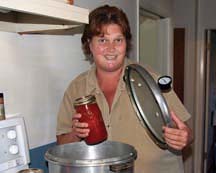 Today, this nearly lost art is being revived all around the world as part of what is called the Food Security movement. On the first weekend in May, Powell River saw a whole weekend of workshops that encouraged people to learn more about some of the traditional food skills of the past.
Today, this nearly lost art is being revived all around the world as part of what is called the Food Security movement. On the first weekend in May, Powell River saw a whole weekend of workshops that encouraged people to learn more about some of the traditional food skills of the past.
I attended a workshop called Pressure Canning. I understood the basics of canning in a big pot of boiling water, and I can recognize a pressure cooker when I see one, but beyond that I didn't have a clue of what to expect. You might call me a "pressure canning virgin."
A dozen or so eager learners clustered together in the kitchen at the Foursquare Church to learn just how to use pressure cookers and canners. I don't know about the other participants, but I was mostly concerned with two things:
How not to poison people with my canned goods and how to avoid blowing up the kitchen with the pressure cooker.
Under the very experienced hand of Peggy Fedor and her willing husband and assistant Al, we learned how to prepare jars for canning, how to use the pressure canners, and how pressure canning is different from hot water bath canning. Peggy explained that, while water canning is fine for acidic fruits, sugar and vinegary canning, when it comes to low acid food like fish, meat and many vegetables, the safest way to can is with a pressure canner. This is what I needed to hear, the safe way to can or how to avoid poisoning my relatives with my home-canned gifts.
Then Peggy turned the dials on this huge pot, opened it up, popped in some jars of salmon and taught us how to watch the pressure gauge. Although intimidated at first, and expecting the fish to explode throughout the room, I soon began to understand the basics of pressure canning.
Energized by delicious samples of home pressure canned salmon and beef, we watched as Peggy actually turned raw fish into canned fish and offered us a myriad of tips only an experienced canner would know.
Peggy wove her lesson with tales of her own canning history, a history that stretches back over 40 years. She started pressure canning when she lived on a farm with no electricity and used a propane stove to can meats, sausages, vegetables and much more. Living on a boat also helped her to hone her cooking skill. She claims that in all the years she has been using a pressure canner she has never had anything explode. I found that most reassuring. Today Peggy is a valuable resource to our community on how to prepare and store food.
Canning and pressure canning are excellent ways to use foods that we grow or buy on sale. When there is an abundance of any food it just makes economical sense to preserve as much of it as you can. Watching Peggy cut up a whole salmon and stuff it into little jars made me realize what an excellent way to put food by this pressure canning business is. She also told us that jars of pressure-cooked food are an ideal solution for travelers, campers and boaters. No electricity is required to keep the food fresh once it is canned and as she puts it, "You work hard for one whole day and have food for a long long time."
In a world of tightening budgets, now, more than ever, it is a great idea to learn these traditional food skills.
Powell River has such an abundance of fruit, vegetables and fish that it makes sense to develop skills that will allow us to grow, preserve and eat much of our own food and reduce our dependence on bringing in food from outside the area.
After an hour and a half I had conquered the basics of pressure food canning, let go of most of my fear, and have sworn to try it. I no longer believe I will blow the kitchen up or send toxic food to my loved ones, and am one step closer to the land than I used to be.
Want to know more?
To learn more about how you can grow, harvest and preserve local food, contact David Parkinson at 604 485-2004 or david@prfoodsecurity.org. To be sure you don't blow up your kitchen or make toxic food for friends, and for lots of recipes, check out online resources such as www.homecanning.com.
Food Swings
A user's guide for dealing with call of food
Do you eat when you're upset? Do you crave sweets when you're angry? Carbs when you're happy? Fried food when you're anxious?
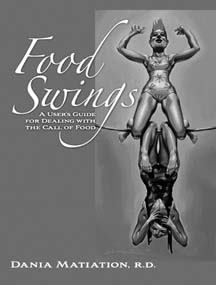 We live in a society of consumption and as consumers some of us reach for food when we are in the mood to consume says registered dietician Dania Matiation whose new book, Food Swings, deals with the call of food.
We live in a society of consumption and as consumers some of us reach for food when we are in the mood to consume says registered dietician Dania Matiation whose new book, Food Swings, deals with the call of food.
In Food Swings Dania explores why we eat when we aren't hungry and how to transform your relationship with food.
Many people are emotional eaters. "I was an emotional eater for years," Dania confesses. "I grabbed comfort food like chips and dip when stressed."
It was this relationship with food that prompted her to write the book. "I had finally come to terms about eating, that it was about health and not weight."
Many of our food issues can be traced back to babyhood. "How we parent and deal with food around our kids sets the ground work for how they deal with food as adults," says Dania.
She recalls a situation where a frustrated mother was doing her utmost to get her baby to finish his bottle finally blurted out: "Are you going to be one of those babies who never finishes his bottle?"
"This mother was well intended but the baby was full."
Children don't have an appetite for a number of reasons. "Sometimes they've been grazing all day and they aren't hungry at mealtime."
While sorting through her own relationship with food, Dania realized she did not have the same loving, caring voice for herself as she did for her children and that she used food to numb herself. By allowing herself to feel her feelings and connect with her spirit, Dania was able to calm her cravings, slow down her eating, and her life and be more conscious.
Food Swings provides eight strategies for food users. After each strategy there are ideas and practices to follow such as slowing down and making a connection with food and being more aware of hidden persuaders (such as the smell of popcorn at the theatre).
"It's about respecting your body and yourself."
For more information visit Dania's website at www.the-art-of-eating.com.
Family Matters
By Isabelle Southcott
Too much of a good thing can be bad.
Now that's a contradiction if I ever heard one but if you think about it, you'll see the truth in that statement.
With summer vacation but a mere memory it's time to get back into a routine. Although our holidays were great, my sleeping, eating and exercising patterns are all out of whack as the result of being away from regular life. And for some reason, all my clothes feel tighter.
I'm now paying the price for my over-indulgence and like many I'm hitting the gym and trails harder than ever, watching what I eat and maintaining a healthy lifestyle.
A healthy lifestyle is about more than food. It's about exercise, your physical and mental health and making other healthy choices that are good for you and your family.
Healthy habits begin at home. It's a bit of monkey see, monkey do. Children watch what their parents do and even if you tell them "do as I say, not as I do," they will imitate their parents.
Despite efforts not to do as our parents did, we often find ourselves patterning our habits and behaviour after them especially in stressful situations. When we lost control and allow ourselves to be governed by our emotions, we tend to go in autopilot and often react without thinking.
Routines are good for brains and bodies. We improve our skills and our games by practicing over and over again. We get fitter by working at it. Much as we'd like to just read a book once and suddenly become an expert swimmer, golfer or even a doctor, unfortunately it doesn't work like that. You need to apply what you learn.
Our brains feel rusty after being on vacation. It's hard to concentrate at school and at work after being off. There you are, sitting at your desk and all of a sudden you catch yourself daydreaming of being at the cabin or the cottage!
Don't be too hard on yourself, this too will pass and before you know it you'll be able to focus once again.
Some moms have been doing the back to school dance for days while others are dreading the thought of making lunches day after day. My own kids have mixed feelings about going back to school. They're looking forward to seeing their friends but bemoaning their loss of freedom.
And so it is with mixed feelings that we kiss summer goodbye and say hello autumn, hello school and hello routine.
Wildwood celebrates 80 years of community spirit
By Dagmar McKenzie
Almost a decade ago my husband, Neil, and I moved to the quiet little community of Wildwood where I was invited to attend ratepayers meetings at James Thomson School. Eager to familiarize myself with the neighbourhood, I went to several meetings where I was quite impressed with the level of interest and caring shown by these "Wildwoodians." People knew their neighbours and were aware of what was broken, what needed fixing or improving, as well as issues big and small that concerned the community. This dedicated group met once a month to keep themselves up-to-date and informed and to act on issues to better the lives of all.
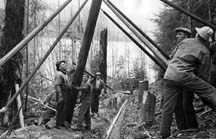 I have lived in several cities, countries, even, and have never felt so much a part of a community. These Wildwoodians are people people. They are proud of their history, their farms and gardens, their community and its future. As a James Thomson teacher I noticed that at nearly every ratepayers' meeting safety issues were raised about things that concerned children. Streetlights in dark corners, bus shelters, crosswalks, etc. In the minutes of May 26, 1929 I found this item, "The League (renamed Wildwood Ratepayers, December, 1944) accepted Mr. Hickman's kind offer to put up "GO SLOW" signs on either side of the school for the protection of the children." At a much more recent meeting a young father asked, "Where else in this country can you still find a Leave It To Beaver Neighbourhood?"
I have lived in several cities, countries, even, and have never felt so much a part of a community. These Wildwoodians are people people. They are proud of their history, their farms and gardens, their community and its future. As a James Thomson teacher I noticed that at nearly every ratepayers' meeting safety issues were raised about things that concerned children. Streetlights in dark corners, bus shelters, crosswalks, etc. In the minutes of May 26, 1929 I found this item, "The League (renamed Wildwood Ratepayers, December, 1944) accepted Mr. Hickman's kind offer to put up "GO SLOW" signs on either side of the school for the protection of the children." At a much more recent meeting a young father asked, "Where else in this country can you still find a Leave It To Beaver Neighbourhood?"
When I first started teaching at James Thomson School I was pleasantly surprised to find a tremendous level of parental and community (Wildwood, Sliammon and beyond) involvement. I learned quite a bit about the history of my new neighbourhood in conversation with families at the school--did I mention social studies projects?
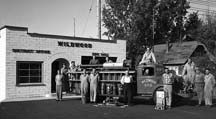
One of my really memorable experiences was taking my grade 2/3 class for a tour of Wildwood on Steve Bennett's double-decker bus. Class parents, Mary Ann Filewich and Barb Simonetta, handed me a script to read out along the way. As tour guide I learned that the Shingle Mill really was a "shingle mill," with a Chinese laundry and a hotel nearby yet, and that there had been a lot of shops and businesses in "Wildwood Heights." By 1957 Lewis's Dairy, started in 1940, had five trucks that delivered milk to houses throughout Powell River. The dairies are gone but thankfully there are still farms--fresh, organic produce at our doorsteps--as delicious, as it is healthy and environmentally responsible.
Last year the three ratepayers Associations, Cranberry, Wildwood and Townsite, hosted an all candidates meeting. One of the candidates wanted to know who and what these "ratepayers" were prior to the meeting. I did a little research in order to give an informed explanation. I learned from Terry Peters, a past president, that the Wildwood Ratepayers became a society in 1929 and have met once a month since then, except in wartime. That is eighty years this year. That is eighty years that the people of this community have had a venue for voicing concerns and helping to maintain Wildwood as a safe community with a semi-rural ambiance. This called for a celebration!
Of course, when you suggest something at a meeting, chances are that you will be asked to form a committee and get on with it, which is exactly what happened. Now I'm having meetings at my home, interviewing residents and spending time at the museum going through decades of Wildwood Ratepayers' minutes as well as Peggy Bird's scrapbooks. Fellow ratepayers are preparing for the event by collecting photos and stories for a timeline that will show what was happening in Wildwood while other events were occurring around the world. For example, the ratepayers started in the year of the great stock market crash. What I thought might be a dry, academic exercise is turning out to be very engrossing and a lot of fun. I find myself chuckling frequently.
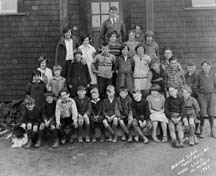 To get a big enough space and at the same time share discoveries with the local children, I have arranged to put our time line together at James Thomson School this September. Students will have an opportunity to be involved and to develop a sense of the rich history of the community in which they live.
To get a big enough space and at the same time share discoveries with the local children, I have arranged to put our time line together at James Thomson School this September. Students will have an opportunity to be involved and to develop a sense of the rich history of the community in which they live.
The project will be displayed at the Italian Hall in Wildwood on Saturday, October 3. Tea, coffee and snacks will be served from 11 to 2 pm. so that locals, past and present Wildwood residents especially, can peruse displays and visit. For those who want to enjoy a night out, the Italian Club will be hosting a dinner/dance at 7 pm, also October 3. Displays will remain around the hall during the dining and dancing. We hope you can come to help us celebrate the people who have helped make our community such a special place.
Business Connections
By Kim Miller
The Newcomers' Social will be back in 2010. You may have attended the social in the past and wondered if it's coming back and when. This year, in its place there will be huge garage sale and community fair at the complex on September 12.
The block on Marine Avenue where Artique is located is becoming our very own artists' row with the newly opened 5th Avenue Studio & Gallery. The studio, which features the paintings of Janet Blair and Donna Van Eeghen, is located at 4712A Marine. Donna was formerly a potter and Janet has been a painter for many years. It is open Monday through Friday 11 to 4 pm and by chance on weekends. Call 604 485-6085 for more info.
Armitage Men's Wear has moved into its new location in the Town Centre Mall. The new space is 25% bigger but feels much bigger and brighter with more display space. "It's much more open visually," says operator Ron Armitage. The store's old location will serve as temporary quarters for Suzanne's during renovations of that store, slated to start in mid-September.
Congratulations to Scott Cameron! Underwriters Insurance Agencies are proud to announce that Scott Cameron received the "Don Ungaro President's Memorial Scholarship" from the Insurance Broker's Association of British Columbia. Scott was Underwriters' summer intern. He returns to Vancouver Island University in Nanaimo in September to continue his studies in the Bachelor of Business Administration Program.
Two new daycare facilities have opened their doors: Creative Kids Family Child Care, owned and operated by Shannon Mortimer is a Christian-based daycare, open to all religions and cultures for two-years-olds and up. Call 604 483-3229 or email kurtmor@telus.net. Sense of Wonder Day Care in the Townsite will be inspiring creativity and expanding the imagination in children six months to five years. For more information call 604 483-7972.
Dave Scherger, owner of Ecoterra Developers, has recently launched a free Powell River website, www.powellriveronline.ca. This is a free online community bulletin board where people and businesses can list goods and services. It is a self-serve site so you can instantly upload, change and delete ads/listings yourself at anytime of day from anywhere!
Powell River Denture Clinic is on the move! Brian Mansell, RD, is moving his clinic to #102-7075 Alberni Street (formerly Creations Hair Studio). Brian and his staff are celebrating their sixth year in business providing complete and partial denture services, relines, repairs and new dentures. You can reach them at 604 485-7654.
Westview Pharmacy has new owners. Since August 1, Rozina and Shehzad Somji have taken over from Carole McCormick who is retiring. Rozina, a pharmacist, and her accountant husband, Shehzad, came to Powell River in 1995. Rozina has been at Westview Pharmacy for five years. The family came to Powell River because of Shehzad's work, but taking over the pharmacy helps make Powell River their permanent home. Rozina says Westview Pharmacy has the widest variety of home health care products in town, from raised toilet seats to bed rails and walkers. The staff pride themselves on fitting athletic braces and supports, from knee braces to supports for carpal tunnel injuries. The pharmacy is also selling Cards by Carly. The $3 cards are produced by a local 13-year-old artist.
Sunshine Coast Pest Control welcomes Paul Hirst who has joined the company as their new director. Paul has a background in science and 35 years in pest management. The company provides environmentally-responsible pest control solutions. Check out their website at www.sunshinecoastpestcontrol.ca, or call 604-485-0898.
Do you have any changes with your business you want Powell River to know about? New managers, new owners or are you moving? Starting a new business? Call the Chamber at 604 485-4051 and we will get you into the next issue of Powell River Living.
Pardon My Pen
When time stands still
By George M Campbell
There are certain places in this world where time stands still and according to WC Fields, Philadelphia is one of them. When asked by a reporter if he had ever visited that city, Fields replied, "Aaah, yes--I spent a week there one night."
We have all experienced this time altering phenomenon at one time or another. Have you ever noticed how time has a tendency to slow down when you are sitting in your car at an intersection waiting for the traffic lights to change? Or when you're at the checkout counter in the supermarket. I don't know about you, but I always manage to get in the slowest moving line-up at the grocery store.
Time almost comes to a full stop sometimes when I am sitting in front of my computer Ð waiting, waiting, and waiting for it to bring up the images I have called for. And quite often the commercial in the middle of the program I am trying to watch on TV goes on at such length and so slowly, that I fall asleep. Time also slows down when I am in the line-up waiting to get on the ferry. I look at my watch, and then I wait for what seems at least ten minutes before I look again, and I find that only two minutes have elapsed.
There are occasions when time speeds up, too. Like when I'm sitting in the dentist's office, hoping my turn will never come. It seems like only seconds before the receptionist is saying, "Okay Mr. Campbell, you can go in now." I notice time has a tendency to speed up as I get older, as well. When I turned sixty my father warned me about this. "From here on in," said my Dad, "It's downhill all the way, and not only that, but you'll begin picking up speed." He was right. It seems the older I get, the faster time goes. Groucho Marx remarked upon this phenomenon when he said, "Time flies like an arrow; fruit flies like a banana."
Time means different things to different people. For example: If you were to ask God, "God, what is a million years to you?" God would reply, "A million years to me is like a minute." And then if you were to ask, "God, what is a million dollars to you?" God would smile and say, "It's like a penny." You would think to yourself, "Wow, imagine that!" And then, very likely, you would say, "God, please give me a penny." And God would reply, "In a minute."
We have perfected a number of instruments to measure time, but nothing to control it. We have digital watches, wind-up watches and battery operated watches. We have grandfather clocks, kitchen clocks and alarm clocks. Speaking of alarm clocks, I prefer the old fashioned kind with a harsh clanging bell to those that awaken one with soft music or a gentle chime. If there's one thing I can't stand first thing in the morning, it's hypocrisy. Another thing I have trouble with first thing in the morning, is getting out of bed. "Time to get up," chirps my wife cheerily. "You've got to be kidding, it's still pitch dark out," I mumble grumpily. "That's because your eyes are still closed," says my better half. "Open 'em up and get outta bed. It's almost 9 o'clock."
Time. I can't seem to escape it. It has me surrounded, and it keeps changing speed. It doesn't seem fair and somebody ought to do something about it. The Canadian government, maybe. Or Barack Obama. We expect him to fix everything else; he might as well have a go at this, too.
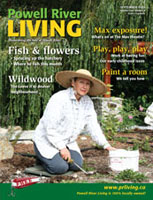
 A community that cares
A community that cares
